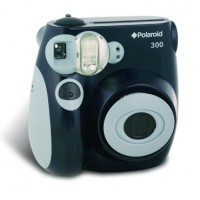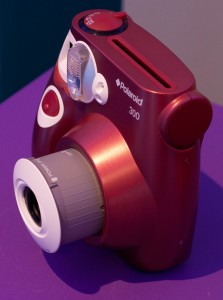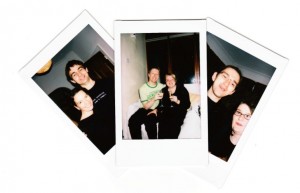
The Polaroid 300 is back after a hiatus of just over two years, and rather cute it looks too. Mmhmm, the original instamatic camera has been revived and relaunched and looks good enough to eat. Seriously, one of my friends took one look at it and asked if it were edible.
I assumed a more conventional approach and took photos with it. I also carried it with me wherever I went and asked friends and family what they thought of it. Aside from the enormous amount of fun I’ve had with it, and the constant stream of ‘Oohs!’ and ‘Aaahs!’ from my nearest and dearest, what’s the Small Aperture verdict on this pretty piece of kit?
Design
Aside from looking delectable, the Polaroid 300 is a very tactile camera. It has a rounded but chunky design that you really want to hold. This is a good thing in more ways than one: although it does have a flat bottom and can stand up, the bottom is too small and it falls over far too easily. Thankfully it seemed to survive the couple of occasions that it did take a drunken wobble, but I wouldn’t want it tumbling from any great height.
The shutter release button is a big thing on the front of the camera and there’s a dial on the top which allows you to select your shooting mode. Everyone seemed to muddle up the two initially, but when you know, you know. Next to said dial is the film slot, where your picture pops out when it’s taken.
The viewfinder is on the far right of the camera. One of my friends who is left-eyed found this problematic, but I didn’t notice, being right-eyed and all. What I did find irritating was my finger’s ability to wander in front of the viewfinder when searching for the shutter release button. They’re a little too close for convenience.
Loading the film into the back of the camera was super-easy. So easy in fact, I worried that I’d done something wrong. There’s a little counter in the bottom right corner showing you how many pictures out of your pack of ten you’ve left to take.
I’ve been playing around with the bright blue model, but there’s a gorgeous burgundy red option. Or you could stick with plain black. But who’d want black for a fun camera such as this?
My favourite-feature award has to go to the on-off mechanism, though: you pull the lens away from the camera body and on it comes. How groovy is that?
Handling
You’ve four shooting modes to choose from: indoor/dark; cloudy/shady; fine; or clear. Whichever mode you’re in, though, the flash will always fire. And to be entirely honest, it’s a bit of a hit-and-miss affair. The lens is freaking huge, though, and it doesn’t tally up to the size of the viewfinder. You’ll get whatever you can see through the viewfinder and quite a bit more besides in your photo.
The picture whirrs out of the slot almost instantly, but you’ll see nothing at all for at least ten seconds. Then your image will slowly begin to emerge through the misty white haze of development. After about 40 seconds you’ll have a much better idea of what you’ve snapped.
Pictures
They’re Polaroid pictures. They’re tiny. The colours are washed out. Everyone’s skin tone is about six billion shades out of whack. I took one photo in the garden, using the cloudy/shady setting (because, well, it was) and it looks as if I took it in the dark. Everything is soft and mushy. But they’re Polaroid pictures; what else did you expect?
I’m going to magnet mine to my fridge.
The verdict
Each picture works out at around £1 a go. That’s not cheap, and some people might find this prohibitive. But it is instantly gratifying and this camera is, essentially, a toy. You’re not going to use it to document your entire trek across the Himalayas or your safari through the Kruger National Park. It’s for parties and for picnics and probably even a bit of posing.
When we’re so accustomed to being able to take hundreds of photos, to discarding the terrible ones, to editing the ones that we do want to keep, that it’s refreshing to revert to old-fashioned one-shot photography. Even if the camera is pretty much a play-thing, it makes you think about your picture that tiny bit more.
Polaroid 300s are available lots of places, including the lovely Amazon, for £79.99 in the UK, or $89.99 from Amazon US. A pack of film (10 exposures) is £12.99.








